Market Adjusts to Trump's Tariff
Published 05-APR-2025 13:32 P.M.
|
14 minute read
- Commentary: Trump Tariff Chaos - Money moving out of “globalisation era” giant stocks - so where will it go to now?
- The other usual stuff: in Tomorrow's Sunday Edition
The great global reset?
A once in a generation opportunity?
A shift of capital out of traditional big US “globalisation era” stocks?
And into smaller stocks with a local focus?
Or will it just be “similar to before but with some different trade terms”?
The US has some urgent goals around bringing back its local manufacturing, securing critical resources supply and reducing its sprawling government debt...
...and plans to get there by "resetting" the “world order”?
Early on Thursday morning President Donald Trump made good on his “everybody gets a tariff” promise...
And it was bigger than many expected.
Basically he just shook up global financial markets and long standing country relationships like a snow globe:

And we are currently in peak uncertainty of what it all could mean...
Nobody knows how or when the dust (or snow, rather) will eventually settle.
Especially the “unintended consequences” that can manifest out of such complex, chaotic situations.
Different countries, companies... and small cap stocks, will share different fortunes and outcomes.
(the first and obvious big winner that came to mind was our stock AL3 - here’s why)
We watched Trump’s “Liberation Day” press conference live, where he announced global ‘reciprocal tariffs’ on all of America’s trading partners.
If you missed it, here’s a very quick summary of what went down.
(besides global stock markets, heyo)
We aren’t going to get too much into the politics of it all.
We mainly focus on how it will affect the sectors of the market we are in.
And which of our stocks could win (or lose) from what may emerge from the chaos.
(same as what most people probably do)
Anyway, here are our key take aways from Trump's global “snow globe shake” from Thursday:
There were some pretty big tariffs being thrown around, some notable ones include:
- 34% tariff on China
- 20% tariff on Europe
- 10% tariff on Australia
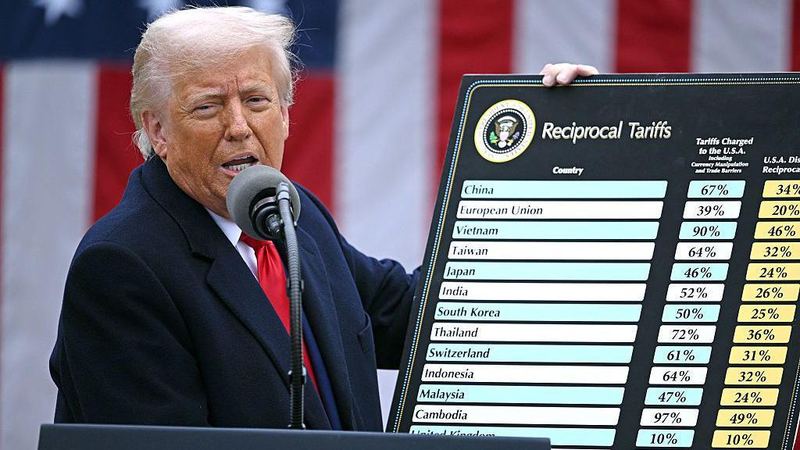
During the speech, markets were volatile...
Gold was immediately up once the speech finished...
Then it came back down again overnight (buy the rumour sell the fact), but has stayed well above US $3,000 per ounce.
The large cap end of the markets (which don’t like uncertainty) had one of the biggest sell offs since 2001, shedding ~$3.1 trillion dollars in value.
Liberation day or liquidation day?
The S&P 500 (the 500 leading companies listed on stock exchanges in the United States) alone shed ~US$2 trillion in value inside a 20 minute window.
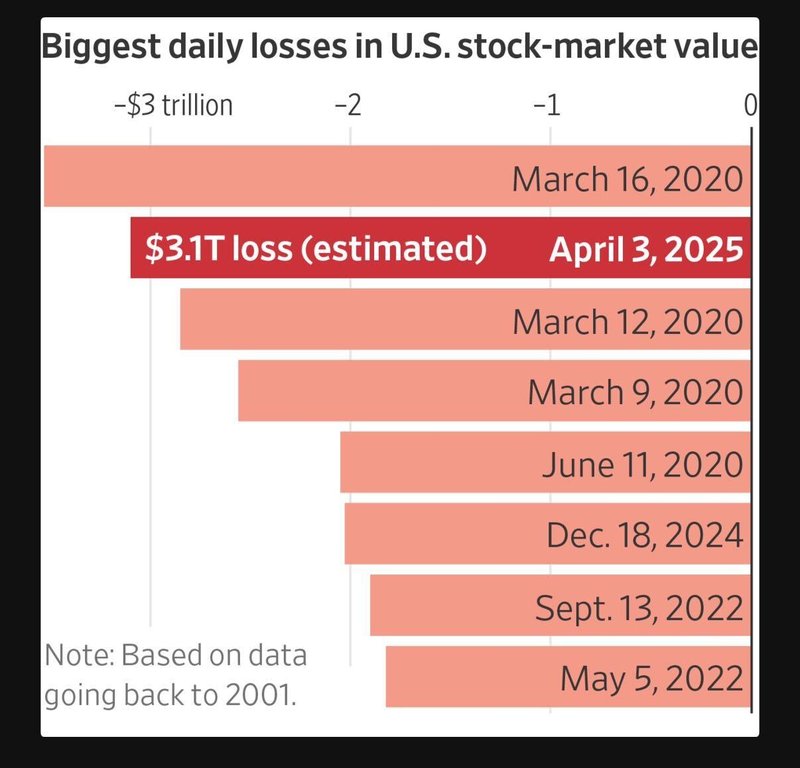
(Source)
This was a full 24 hours ago.
Just overnight China responded to Trump’s 34% tariff with a matching 34% tariff on all imported US goods (and sprinkled on top export controls on rare earths):
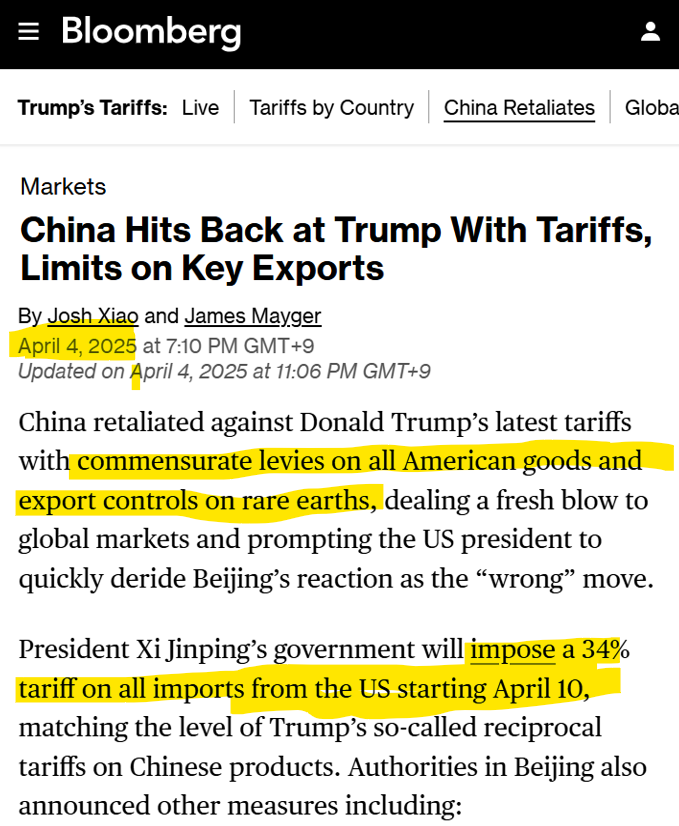
And again, the big end of the US markets didn’t like it in last night’s session:
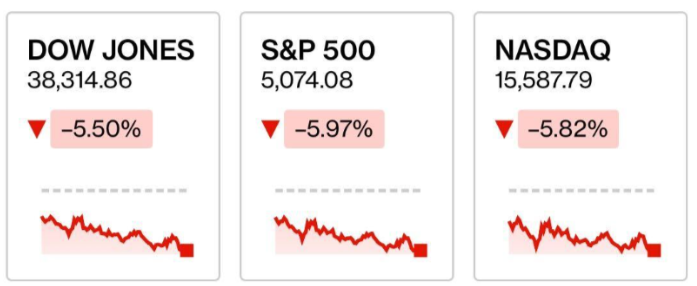
Keep in mind these indexes represent giant US companies.
Basically it means people are pulling money out of the bigger end of the US stock market.
Many of these giant companies sell their products into global markets, using sprawling global supply chains to cheaply manufacture these products.
...and will suffer most from tariffs.
These types of giant, global stocks had been attracting all the capital before Trump hit the reset button on global supply chains and markets.
The small end of the ASX (our Portfolio and watchlist at least) was down a little bit in the chaos, but held up relatively well given the circumstances, much better than expected actually.
So investors are pulling capital from its previous home - giant companies in global markets with global supply chains.
And it’s not even THAT much money coming out in the scheme of things...
If you step back and look at this in the context of time - the S&P 500 is just back to where it was 12 months ago.
So capital is coming out at close to all time highs, way above where the market was only 12 months ago.
One of US investor we follow pretty closely put context around the move with his take:
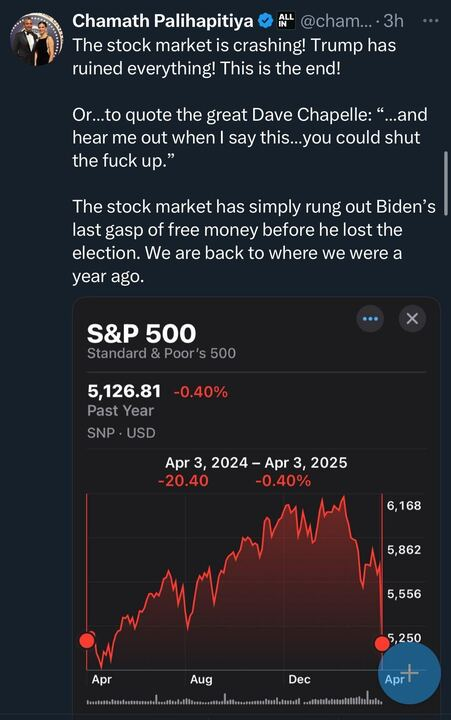
(Source)
So cash is coming out of the big end of the market, and the people and funds cashing out aren't necessarily in a world of pain...
Meaning they will likely be looking to redeploy?
So, where will this money go now?
Probably into the places that new US policies and executive orders are trying to incentivise it to flow into, right?
Places like local US manufacturing, defence supply chains and critical metals and local US energy supply.
US aside, the current “chaos and uncertainty" will get other countries to rethink their own supply chains too, opening up opportunities for smaller companies with local projects and businesses to step in to fill the gaps.
So is this a great global reset?
Money comes out of the giant incumbents that were leveraging the “old world order” of unfettered globalisation?
...and into emerging companies with the right projects or businesses that match what the new global reset is incentivising to achieve?
So where to place bets, and what to avoid?
This is the conversations that governments, institutions, investors and fund managers (and us) are all having...
And with an uncertain medium term future, safe haven assets like gold will be seen as attractive places to park money.
(we think the gold price is going to stay high white all this plays out - we expect KAU to be the big winner if they can successfully ramp up their gold production as planned - read more here)
What the last 48 hours of sell offs in mega cap stocks means is that more money moves to the sidelines and eventually needs to start looking for new homes that support the goals of the global reset...
Some money moving out of big, global stocks. Where is it going ...?
Prior to the last 48 hours, the “magnificent 7” US tech companies made up 30% of the total US stock market value
(and the US makes up 64% of the combined value of all world stock markets).
These companies are NVIDIA, Facebook (Meta), Google (Alphabet), Microsoft, Apple, Amazon and Tesla.
To get a sense of the scale... the “magnificent 7” alone are bigger than any other stock market in the world.
The mag 7 had vacuumed up a disproportionate amount of available capital.
The below image shows the market cap of just one of them, chipmaker NVIDIA, in October last year, compared to the market caps of the biggest mining companies in the world.
(yes those two, small blue and purple bubbles are BHP and RIO... - two of the biggest mining companies)
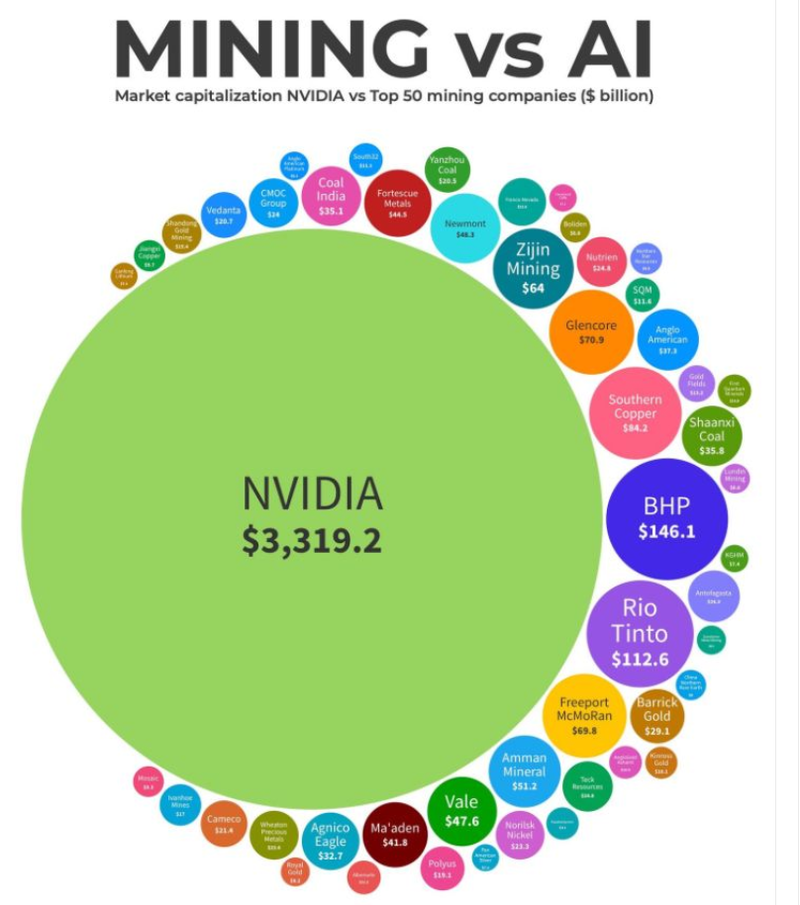
(Source, Mining.com October 28, 2024)
With Trump’s Liberation Day announcement, large amounts of cash have been taken out of the big end of the market.
Out of companies leveraged to globalisation and selling into global markets.
We think that this may lead to a sequence of events that goes something like this...
(using the above image of just cash deployed into NVIDIA versus mining to illustrate the example)
Step 1: a part of that big green NVIDIA blob is turned to liquid cash (along with the other major, global stocks that attracted the vast majority of capital over the last few years)
Step 2: US investors take heed of Trump's talk and incentives to “make resources in the US great again”, manufacture locally, mine more gold, secure critical metals, build plants and ships in the US.
Step 3: Smaller companies with US projects and businesses that match Trump’s incentives become homes for newly freed up cash, stock prices go up (we predicted this a few weeks ago - read it here)
Step 4: Other countries follow the lead from the US and money flows into their own critical minerals supply chain, local manufacturing, energy independence and military capabilities.
Result: Greater investment in “real assets” and localised businesses is prioritised in the de-globalisation “reset” - these stock prices go up.
(and while these gyrations are playing out - safe havens like gold and silver will remain high)
We think commodities could outperform globally, and we think projects inside the US could outperform even more.
A few weeks ago Trump published an Executive Order to boost domestic production of minerals like copper, gold, lithium and uranium - we wrote about it here:
How the U.S. Just Made Gold Mining a Strategic Priority
Highlighting the importance of these commodities was the decision by Trump to leave out metals and critical minerals from the latest round of tariffs.
The US is still very reliant on imports for most of these so perhaps Trump didn’t want to rock the boat any further?
Here’s the headline on these exclusions:

(Source)
We are Invested in companies with US based assets, including:
- SS1 - Gold-Silver-Antimony in Nevada, USA. Largest pre-development primary silver resource on the ASX. Read our latest note
- JBY - Gold in Nevada, ~1.4M ounce fold equivalent JORC resource and room to grow that further. Read our latest note
- HAR - Gold in California. In old gold rush country with a target to grow its resource to 1M ounces. Read our latest note
- GUE - Uranium Exploration + Enrichment. A number of uranium exploration tenements in North America and stake in a uranium enrichment technology business. Read our latest note
- GTR - Uranium exploration in Wyoming. Working toward a scoping study on its project. Read our latest Quick Take
- 88E - Oil exploration in Alaska, some oil production in Texas and recently signed a ~$60M farm out deal pending a private company’s potential IPO... Read our latest Quick Take
- PFE - Lithium exploration in the Smackover Region of Arkansas next to Exxon, Albemarle, and Standard Lithium. Read our latest quick take.
“Stockpiling” to drive the next wave of investment in mining?
With these tariffs, Trump has sent a signal to the world that if you want to do business with America, it is going to cost you.
No one escaped the tariffs, even traditional allies of the US including Australia, Japan and Europe got slapped with a tariff.
Negotiation tactic or not, the perception is probably that the United States is becoming a less reliable ally, which means that countries will need to build up their own capabilities and local supply chains.
(Even in Australia we are having the conversation about halting gas exports to our ally Japan to use it for the domestic market).
The world is becoming more fractured and this may lead to what is called “bifurcated markets” - essentially two prices for the same good based on geographic location.
(Like how a standard fillet steak costs $200 in a Tokyo restaurant, versus $50 in Australia, where cattle grazing ground is plentiful)
That type of dislocation could lead to a rush by countries/regions to create and stockpile “strategic mineral reserves”.
(which would be a big win for the mining industry and resources projects in the short-medium term).
It has happened before in the 1970s oil market when the world experienced a giant oil price shock.
Embargoes on oil from the Middle East pushed prices higher and also forced countries to start thinking about security of supply going into the future...
No one ever wanted to experience an energy price shock like the 1970s again...
So countries set up strategic petroleum reserves.
(The US was one of those countries to do that)
There’s a good Bloomberg article that we think explains it really well:
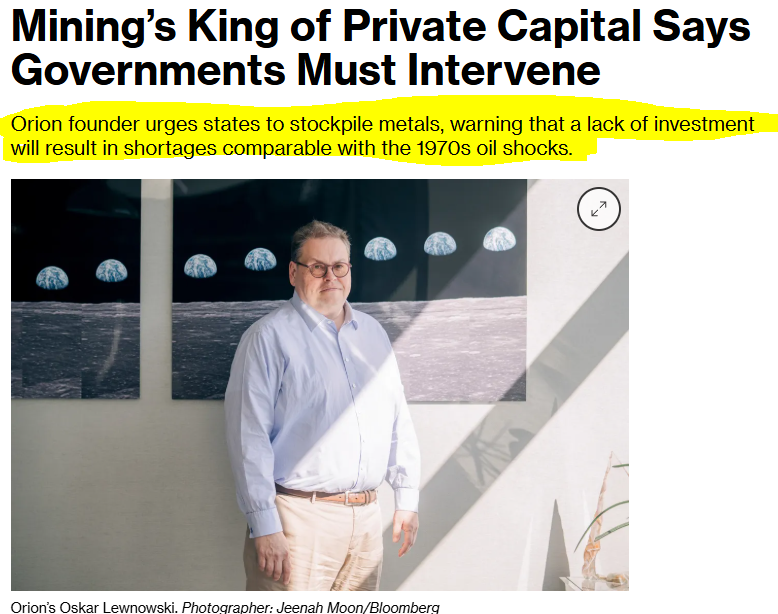
(Source)
For those who want to come back to that article later (or just don't want to pay for it), here is the quick summary:
- Commodity prices are likely to rise as global supply chains adjust to new tariff structures and geopolitical shifts.
- Governments may respond by creating strategic reserves for critical minerals, mirroring past efforts in oil markets.
- The lessons from the 1970s oil shock highlight the long-term importance of securing stable supply chains to avoid future disruptions.
Our view is that tariffs, while they may have other intended purposes, could create a sense of urgency to boost supply out of the mining industry.
(an industry that is notorious for being slow and underfunded)
Remember all the talk about how it takes on average 14-17 years to make a new mineral/resource discovery and build a mine to bring it into production...
Ultimately that sense of urgency could be the trigger for new capital to come into the industry.
An industry which for a long time has relied on billionaires, family offices and at the very risky exploration end, retail investors...
(most money had been busy sitting in NVIDIA, the magnificent 7 and other giant global stocks)
The new capital could be government funding or sovereign wealth funds - like we are seeing out of the middle east...

(Source)
Who are the direct winners from the Trump Tariffs?
The standout winner of these tariffs is hands down the US manufacturing space.
By increasing the cost of imports, the incentive to try and produce things inside the US increases.


Trump has been pretty public about how he feels America is behind its global peers when it comes to manufacturing.
(one peer in particular... China)
But our thinking is that a sustainable push to rebuild the US manufacturing industry can only happen IF the US is able to compete with the rest of the world on cost.
The US won't need to be the absolute cheapest... BUT it also can't afford to be an order of magnitude more expensive relative to China and other global peers.
So the US needs to find as much efficiency as possible to try and control manufacturing costs...
The only way the US can do that is by integrating as much technology as possible into its manufacturing industrial base.
It’s hard to find many small cap companies on the ASX that can benefit from all of this...
BUT we think our Investment AML3D (ASX:AL3) is a big winner here.
AL3 has developed a robotic 3D printing tech that can build large industrial parts in a fraction of the time taken in the traditional manufacturing process.
AL3 has recently set up a new facility in Ohio, USA and has customers that include the US Navy.
With Trump’s emphasis on building a BIGGER and much QUICKER industrial sector, we think systems like AL3’s will become a centrepiece of the US push to modernise manufacturing.
Here is what Trump said specifically on the shipbuilding industry in the US.
“We used to make so many ships... we’re going to make them very fast, very soon”
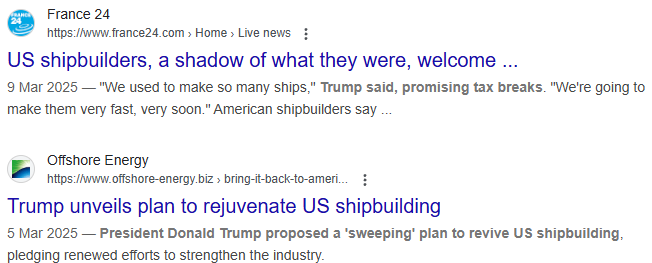
AL3’s technology unlocks these capabilities for the US shipbuilding industry, and we think that it will be a big player in the US’s ambitions to develop a strong domestic manufacturing industry.
We put out a note on AL3 on Thursday (on the day of Trump’s Liberation day press conference).
Check out that note here: Trump announces tariffs to revive US shipbuilding - AL3 3D prints metal ship parts fast... in the USA.
Speaking of companies that will benefit from operating in the US...
One of the US based companies in our Portfolio announced they are part of a US$920M US Federal Government contract.
On Tuesday our cybersecurity Investment WhiteHawk (ASX:WHK) announced that it had secured a sub-contractor position with the US Federal Government.
A long awaited contract win that the market had probably lost hope in seeing
(with the loss of hope priced into the stock)
WHK was up 250% on the day of the announcement, and finished the week up over 100% at the 1.8 cent mark.
We don’t yet know actual revenue numbers WHK will get from this contract, so there could be more share price action to come when this is revealed to the market.
A retracement is normal after announcements like these as some long suffering holders look to lock in some gains.

The past performance is not and should not be taken as an indication of future performance. Caution should be exercised in assessing past performance. This product, like all other financial products, is subject to market forces and unpredictable events that may adversely affect future performance.
We think that the share price reaction on the day was a function of low market expectations for WHK after years of delays in securing a big US contract.
When WHK announced this big news, it wrongfooted the market and investors flocked into the company.
Better late than never.
So in summary, the coming weeks will be interesting to watch in global markets as companies and governments react to the “snow globe shake”.
...and as the chaos settles down we should see the winners in the small end start to emerge.
Are you a s708 sophisticated investor?
If you qualify as a sophisticated investor and would like to see “s708 only” sophisticated investor opportunities: Subscribe to Next Cap Raise.
You will need to send us a valid certificate from a qualified accountant confirming you qualify as a sophisticated investor.
Have a great weekend,
Next Investors
General Information Only
This material has been prepared by StocksDigital. StocksDigital is an authorised representative (CAR 000433913) of 62 Consulting Pty Limited (ABN 88 664 809 303) (AFSL 548573).
This material is general advice only and is not an offer for the purchase or sale of any financial product or service. The material is not intended to provide you with personal financial or tax advice and does not take into account your personal objectives, financial situation or needs. Although we believe that the material is correct, no warranty of accuracy, reliability or completeness is given, except for liability under statute which cannot be excluded. Please note that past performance may not be indicative of future performance and that no guarantee of performance, the return of capital or a particular rate of return is given by 62C, StocksDigital, any of their related body corporates or any other person. To the maximum extent possible, 62C, StocksDigital, their related body corporates or any other person do not accept any liability for any statement in this material.
Conflicts of Interest Notice
S3 and its associated entities may hold investments in companies featured in its articles, including through being paid in the securities of the companies we provide commentary on. We disclose the securities held in relation to a particular company that we provide commentary on. Refer to our Disclosure Policy for information on our self-imposed trading blackouts, hold conditions and de-risking (sell conditions) which seek to mitigate against any potential conflicts of interest.
Publication Notice and Disclaimer
The information contained in this article is current as at the publication date. At the time of publishing, the information contained in this article is based on sources which are available in the public domain that we consider to be reliable, and our own analysis of those sources. The views of the author may not reflect the views of the AFSL holder. Any decision by you to purchase securities in the companies featured in this article should be done so after you have sought your own independent professional advice regarding this information and made your own inquiries as to the validity of any information in this article.
Any forward-looking statements contained in this article are not guarantees or predictions of future performance, and involve known and unknown risks, uncertainties and other factors, many of which are beyond our control, and which may cause actual results or performance of companies featured to differ materially from those expressed in the statements contained in this article. S3 cannot and does not give any assurance that the results or performance expressed or implied by any forward-looking statements contained in this article will actually occur and readers are cautioned not to put undue reliance on forward-looking statements.
This article may include references to our past investing performance. Past performance is not a reliable indicator of our future investing performance.

